Spices that Heal Us NCERT Solutions | English for Class 6 PDF Download
| Table of contents |

|
| Let us do these activities before we read |

|
| Let us think and reflect |

|
| Let us learn |

|
| Let us listen |

|
| Let us speak |

|
| Let us write |

|
| Let us explore |

|
Let us do these activities before we read
Page 93
Q1: A spice is any seed, fruit, root, bark, leaf or any other part of a plant used to give taste and colour to our food. Try to recall the names of three spices that are used for cooking in your home. Write them below and share your answers with your teacher.
(a) _______________
(b) _______________
(c) _______________
Ans: (a) Turmeric
(b) Corriander
(c) Ginger
Q2: Given below are pictures of some spices. Work in pairs and write what you call them in your language. Their names in English are given in the last column. Share your answers with your teacher.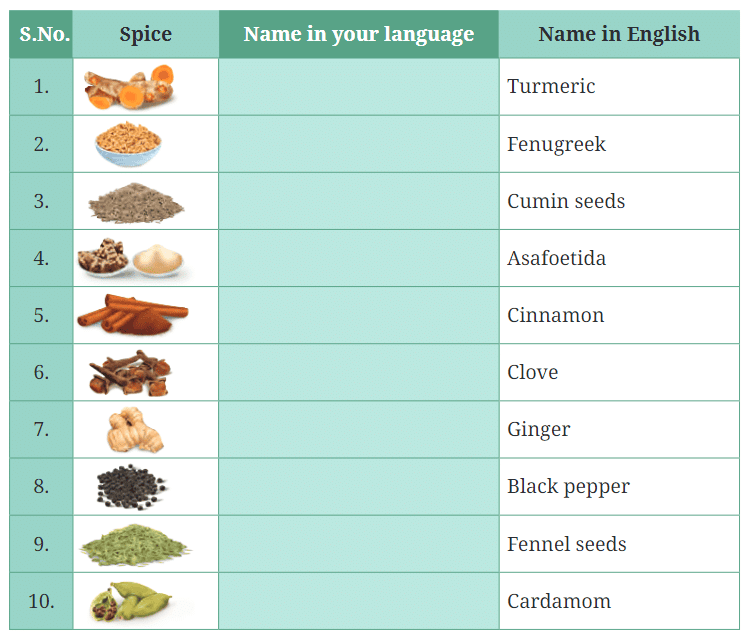 Ans:
Ans: 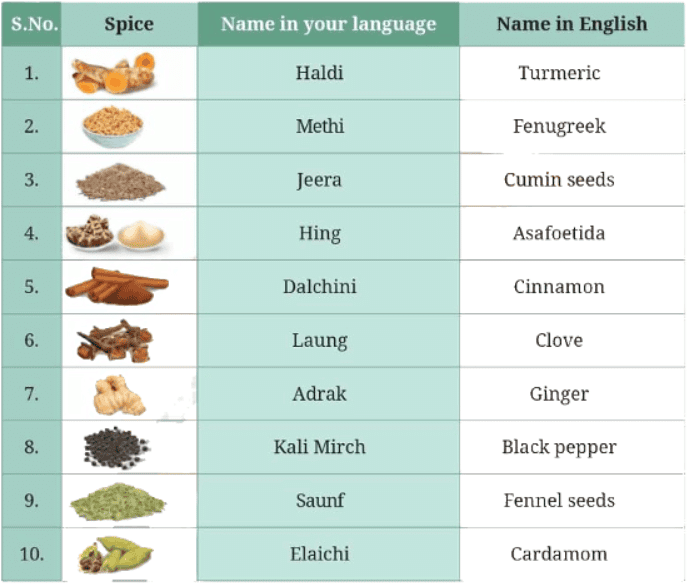
Let us think and reflect
Page 95
Q1: Read the given lines and answer the following questions.
‘When I was a child, I learnt them from my grandmother. She used to find cures for most of the weather-related common illnesses in the kitchen.’
(a) Where exactly in the kitchen did her grandmother find the cures?
Ans: In the spice box and herb jars in the kitchen.
(b) Give one example of weather-related common illnesses.
Ans: Cough and cold.
(c) What kind of relationship did the speaker have with her grandmother?
Ans: The speaker had a close and affectionate relationship with her grandmother, learning and sharing knowledge about natural cures.
Q2: Fill in the blanks to complete the sentence.
Daadi soaked methi seeds overnight and drank the water in the morning to manage _____________________ and _____________________.
Ans: blood sugar levels and body weight.
Q3: Circle the spice that is not useful for body pain according to Daadi’s letter.
(a) Turmeric
(b) Ginger
(c) Fennel seeds
(d) Black pepper
Ans: (c) Fennel seeds
Q4: Why did Daadi ask Vikram and Vaibhavi to share the natural cures with their friends?
Ans: Daadi asked Vikram and Vaibhavi to share the natural cures with their friends to help others benefit from these remedies and pass on the knowledge.
Q5: What was Daadi’s final advice to Vikram and Vaibhavi?
Ans: Daadi’s final advice was to always consult an elder before using the natural cures.
Q6: How do we know that natural cures are passed from one generation to another?
Ans: We know that natural cures are passed from one generation to another through the speaker's experience of learning from her grandmother and sharing it with her grandchildren.
Q7: Why do you think we should know about the healing properties of spices?
Ans: We should know about the healing properties of spices because they provide natural and effective remedies for various health issues and help in maintaining overall well-being.
Let us learn
Page 96, 97
Q1: You have read the uses of spices in the letter. Complete the following table with the help of your teacher. You may use the words from the box given below.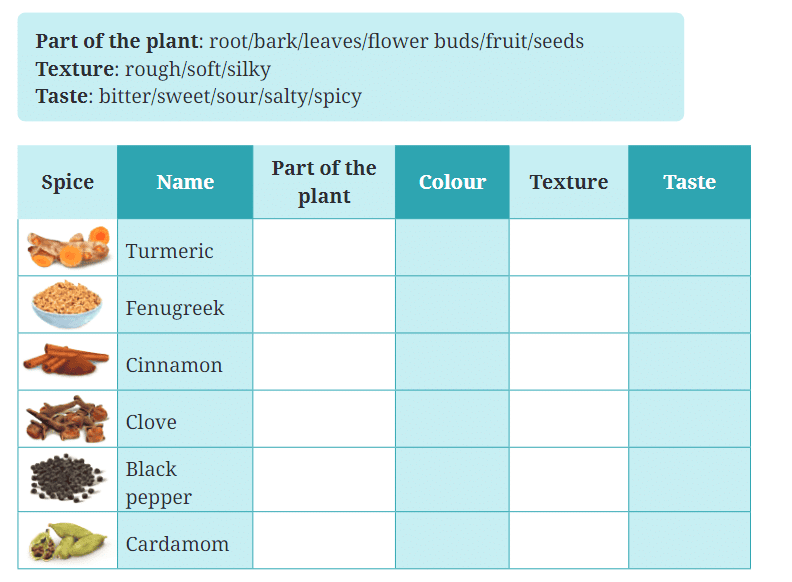
Ans: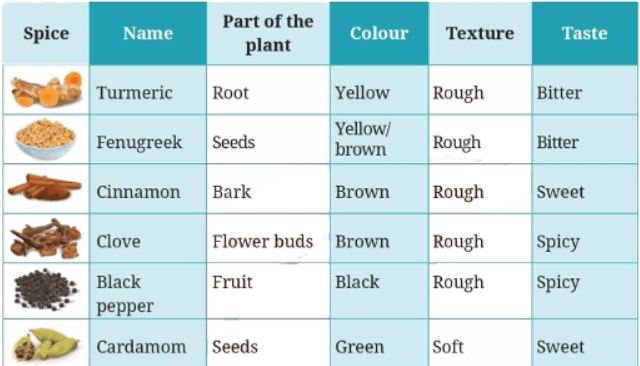
Q2: Read the sentences given below.
- You may share them with your friends.
- You should try to remember these cures.
- It can help to control cough and cold.
- You must consult an elder before you use them.
- I need to soak the methi seeds overnight.
- I used to put heeng water on your tummy.
(a) The words given in Column A are helping verbs. Match the helping verbs in Column A with their functions in Column B.
 Ans:
Ans:
- may – compulsion
- should – advice
- can – ability
- must – necessity
- need to – suggestion
- used to – past habit
(b) Complete the following dialogues with any four modals from the table given above.
Ajay: Anand had a fever last week. He (i) _____________ take good rest.
Suman: Yes, he (ii) _____________ or he will fall ill again.
Ajay: He (iii) _____________ take grandmother’s natural cures.
Suman: Yes, we (iv) _____________ remember how effective they are.
Ans:
Ajay: Anand had fever last week. He (i) should take good rest.
Suman: Yes, he (ii) must or he will fall ill again.
Ajay: He (iii) can take grandmother’s natural cures.
Suman: Yes, we (iv) need to remember how effective they are.
Let us listen
Page 98
Q1. You will listen to the benefits of Tulsi (Holy Basil), a common herb. As you listen, complete the factsheet given below. (refer to page 102 for transcript)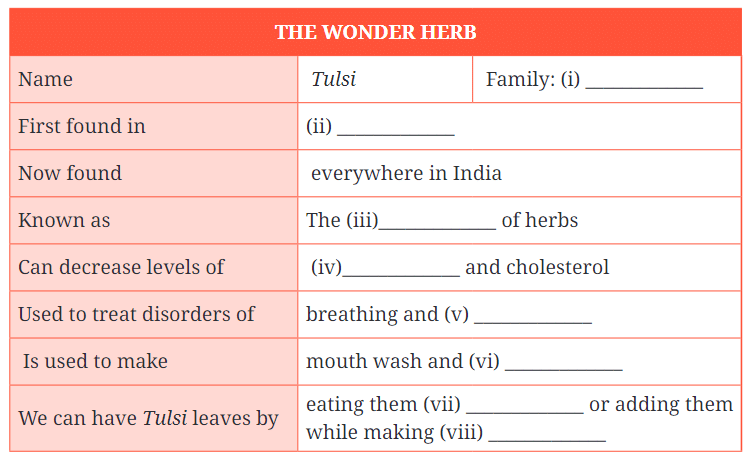 Ans:
Ans:
Let us speak
Page 98
Q1: Daadi told Vikram and Vaibhavi about many spices. Choose one spice and introduce yourself as that spice to the class.
Ans: Hello Everyone!
I am Turmeric, known as Haldi in Hindi. I come from the root of the Curcuma longa plant, and I’m bright yellow. People love me for my bitter and earthy taste.
I’m not just used for cooking; I’m a wonder spice with numerous health benefits! I can help improve energy levels and digestion, and I am great for reducing body pain. Many people use me as a natural remedy for various ailments. You might find me in curries, teas, and even beauty products.
I am proud to be a part of your kitchen and your wellness routine!
Thank you!
Q2: Before you speak, make a spicy headband for the spice you chose. Follow the steps given below.
Use the headband while introducing yourself as the spice.
Ans: Steps to Make a Spicy Headband
- Cut out strips of paper: Take a sheet of paper and cut out strips that are 2 inches wide. You’ll need enough length to fit around your head.
- Join the ends: Take the two ends of the paper strip and join them together to form a band that fits your head. You can use glue, tape, or staples to secure the ends.
- Make a small card: Create a small card with a picture of turmeric. You can draw and color it, or print a picture of turmeric if you prefer.
- Attach the card to your headband: Attach the card with the picture of turmeric to the front of your headband. You can use glue, tape, or staples to secure it.
Example Introduction
While wearing your headband:
Hello everyone!
I am Turmeric, known as Haldi in Hindi. I come from the root of the Curcuma longa plant, and I’m bright yellow. People love me for my bitter and earthy taste.
I’m not just used for cooking; I’m a wonder spice with numerous health benefits! I can help improve energy levels and digestion, and I am great for reducing body pain. Many people use me as a natural remedy for various ailments. You might find me in curries, teas, and even beauty products.
I am proud to be a part of your kitchen and your wellness routine!
Thank you!
Q3: Mention the following while speaking.
- your name
- part of the plant
- colour
- texture
- taste
- benefits
Ans: Hello Everyone!
I am Turmeric, known as Haldi.
Part of the plant: I come from the root of the Curcuma longa plant.
Colour: I am bright yellow.
Texture: My texture is rough.
Taste: I have a bitter and earthy taste.
I am not just used for cooking; I am a wonder spice with numerous health benefits! I can help improve energy levels and digestion, and I am great for reducing body pain. Many people use me as a natural remedy for various ailments. You might find me in curries, teas, and even beauty products.
I am proud to be a part of your kitchen and your wellness routine!
Thank you!
Let us write
Page 99
Q1: Vikram’s grandmother shared two natural cures to cure his cough in her earlier letter. It was kept outside and a few drops of rain fell on it. Some of the words got washed away by the rain. Help Vikram complete the natural cures. Use the phrases given in the box below. There are two phrases that you do not need.
Natural Cures for Cough
(a) To prepare this home remedy, you just need ginger and honey. First, take ____________________, grate it, and take the juice from it. Take about two teaspoons of this juice and add about two and a half teaspoons of honey to it. Mix it properly. Warm ____________________ slightly on very low heat for a minute. Then ____________________ about three to four times a day to get relief from cough. Have patience to see the effct as natural cures ____________________ with ginger and honey might take some time to show results.
Ans: To prepare this home remedy, you just need ginger and honey. First, take a piece of fresh ginger, grate it and take the juice from it. Take about two teaspoons of this juice and add about two and a half teaspoons of honey to it. Mix it properly. Warm the mixture slightly on very low heat for a minute. Then you can have it about three to four times a day to get relief from cough. Have patience to see the effect as natural cures for cough with ginger and honey might take some time to show results.
(b) To prepare the second ____________________ for cough, take about 10 grams of each long pepper, dried ginger and basil leaves. Add four to six small cardamoms and ____________________ a fine powder. If you take this powder with an equal ____________________, it will give you relief from cough.
Ans: To prepare the second home remedy for cough, take about 10 grams of each long pepper, dried ginger, and basil leaves. Add four to six small cardamoms and grind to get a fine powder. If you take this powder with an equal amount of honey, it will give you relief from cough.
Q2: Now, write a short paragraph on Tulsi based on the completed factsheet in ‘Let us listen’.
Ans: Tulsi, also known as the Queen of Herbs, belongs to the basil family and was first found in North Central India. It is now found everywhere in India. Tulsi is known for its medicinal properties, helping to decrease glucose and cholesterol levels and improve blood pressure. It is used to treat breathing and digestion disorders and has anti-bacterial properties, making it a common ingredient in herbal hand sanitizers, mouth wash, and toothpaste. Tulsi leaves can be eaten raw or added to tea, providing relief from stress and protecting us from various pollutants.
Let us explore
Page 100
Q1: Now that you have read about many spices, can you guess the spices based on the riddles given below? Ans: (a) Asafoetida (Heeng)
Ans: (a) Asafoetida (Heeng)
(b) Ginger
Q2: Fill in the blanks to complete the riddle below. Write another riddle of your own and ask your family members to guess the spice. Ans:
Ans:
Q3: Close your eyes and learn about spices by smelling and feeling them. The teacher may also provide a few different spices to try.
Ans: Turmeric (Haldi):
- Smell: Close your eyes and take a deep breath. You’ll notice a warm, earthy, and slightly pungent aroma.
- Feel: Turmeric is a fine powder with a slightly rough texture.
Fenugreek (Methi):
- Smell: Fenugreek seeds have a strong, slightly sweet, and nutty smell.
- Feel: The seeds are small, hard, and have a slightly rough texture.
Cinnamon (Dalchini):
- Smell: Cinnamon has a sweet, woody, and spicy aroma that is very distinct.
- Feel: It comes in sticks which are hard and have a rough texture.
Clove (Laung):
- Smell: Clove has a strong, sweet, and spicy aroma.
- Feel: Cloves are small, hard, and slightly rough to the touch.
Black Pepper (Kali Mirch):
- Smell: Black pepper has a sharp, pungent, and slightly woody aroma.
- Feel: The peppercorns are small, hard, and round with a rough texture.
Cardamom (Elaichi):
- Smell: Cardamom has a sweet, floral, and slightly spicy aroma.
- Feel: The pods are smooth and firm, and have a slight give when pressed.
|
63 videos|708 docs|70 tests
|
FAQs on Spices that Heal Us NCERT Solutions - English for Class 6
| 1. What are the health benefits of common spices mentioned in the article? |  |
| 2. How can spices be incorporated into daily meals for better health? |  |
| 3. Are there any side effects of consuming spices in excess? |  |
| 4. How do spices contribute to traditional medicine practices? |  |
| 5. Can using spices help prevent diseases? |  |
















